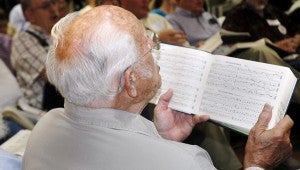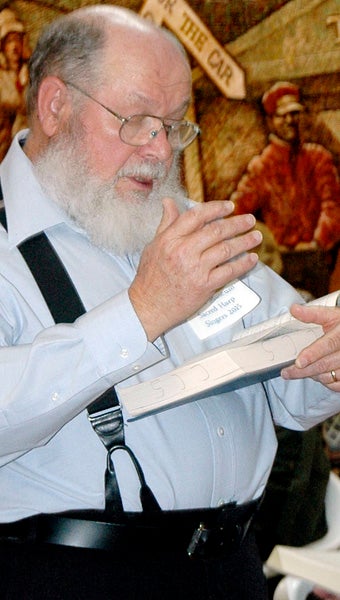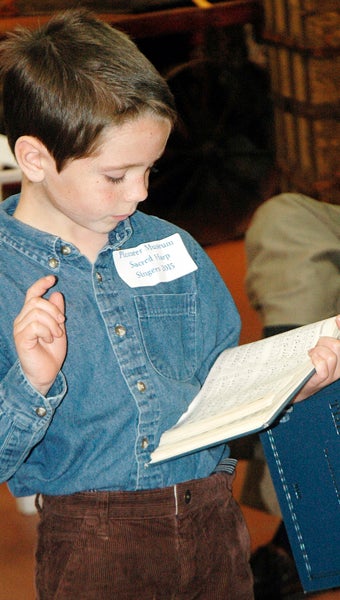Vocal Harps: Singers joined together for the annual Sacred Harp Sing at The Pioneer Museum of Alabama
Published 3:00 am Tuesday, February 24, 2015

The Pioneer Museum of Alabama hosted the 6th Annual All Day Sacred Harp Sing Saturday. The singers sang from the Copper Book. Aubrey Barfield, Niceville, Fla., is a regular at the annual sing and sits and sings with the trebles in the hollow square.
MESSENGER PHOTO/JAINE TREADWELL
- The Pioneer Museum of Alabama hosted the 6th Annual All Day Sacred Harp Sing Saturday. The singers sang from the Copper Book. Royce Sellers, Headland, has years of experience leading the sacred singing. MESSENGER PHOTO/JAINE TREADWELL
- The Pioneer Museum of Alabama hosted the 6th Annual All Day Sacred Harp Sing Saturday. The singers sang from the Copper Book. Royce Sellers, Headland, has years of experience leading while Ewan Eddins, Wicksburg, is just beginning his turns as a leader. MESSENGER PHOTO/JAINE TREADWELL
Dale Volz walked into the Pioneer Museum of Alabama Saturday expecting to see golden harps with musicians plucking the strings and to hear classical music filling the air.
Instead, what Volz heard was a unique blending of voices singing sacred songs a cappella and without reservation or restraint.
“My wife and I thought we were going to hear harps being played, but this is the harp,” Volz said, pointing to his voice box. “We had never heard Sacred Harp singing before, and it was amazing. We really enjoyed it and weren’t at all disappointed that there were no harps.”
Ken Sundberg, who organized the 6th All Day Sacred Harp Sing at the pioneer museum, said Saturday’s sing attracted singers and visitors alike.
“We had more visitors Saturday than we’ve been having,” Sundberg said. “Hopefully, that’s an indication that more people are becoming interested in Sacred Harp and shape note singing.”
Sundberg said the old songs, by in large, are either in minor chords or have minor chords. They have a rather antique structure and a harmony that produces a distinctive sound.
“That stucture allows the voices to be more plantiff and empty and you want to add something to it,” he said. “The voices are prominent and complete the sounds that are Sacred Harp.”
Sundberg said Sacred Harp singers always welcome people to sit in on the hollow square or to just sit, listen and learn more about the singing of shape notes.
Shape note singing was first sung in America in the New England states, but has been maintained in the South.
The Rev. Ed Shirley, pastor of Brundidge United Methodist Church, said he has always been fascinated by shape note singing. He appreciated the opportunity to participate in the Sacred Harp Sing at the Pioneer Museum of Alabama Saturday.
“It’s important to listen to everybody in the room in order to blend and harmonize with the volume of voices that make a total musical presentation in one effort,” Shirley said. He said, for him, it was not easy to enunciate the ‘fasola’ with the shape of the note.
“I was singing ‘watermelon, watermelon’ instead of ‘fa sol la,’” he said laughing.
“Sacred Harp singing has a unique sound that seems to come from the heart. The body is the only instrument of expression. You can lean on a guitar or a piano but, in Sacred Harp singing, you are out there by yourself. Sacred Harp singing is a unique and special way o communicate with the Lord.”
Shirley said the songs are different from those found in standard hymnals.
“They are unique to themselves, and some of them are lonely and even heart wrenching,” he said. “Scared Harp music is a wonderful way to present the poetry and then a unique way of presenting the notes. I’m looking forward to learning more about shape note singing. Saturday’s singing was an uplifting experience.”
Sundberg agreed.
“At the end of the day of singing, you want to hug one another,” he said.






